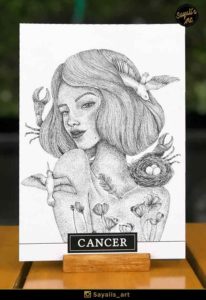In this day in age, we find ourselves surrounded by a never-ending supply of inspiration made available at any moment, in any place, thanks to our mobile devices. While this might be true, there’s nothing quite like physically creating, drawing, or painting something on your own, especially when venturing off into uncharted territory. Sometimes we just need a little push, or we’re not quite sure exactly where to start. That’s why we’ve asked some of the top watercolor artists from the Doodle Addicts art community to spill their secrets, share what they’ve learned, and what that they wish they knew when they started.
1. Don’t fight the watercolor medium. Give yourself over to it and its unpredictable nature.
2. Once you put the paint down, leave it alone. This is when the magic happens. Color will be more vibrant. If you disturb it too much, it can make your colors muddy.
3. Don’t be afraid of letting the paint “mix on the paper”. Some wonderful unexpected things happen.
4. Keep your palette simple to begin with. 6 colors. Warm blue/cool blue, warm red/cool red, warm yellow/cool yellow.
5. Think about the negative space, don’t be afraid of it.
6. Use appropriate watercolor paper for greater success (don’t use paper not intended for water-based materials). Nothing is more frustrating than fighting the paper and having it fray or fall apart.
7. Treat the painting as a meditative “zen” experience. Be in the moment. (Read Frederick Franck’s The Zen of Seeing)
8. Don’t have any expectations. Be open to the outcome.
9. Make sure to use waterproof ink so it will not bleed if you’re using an ink line in your work. I use Noodler’s Bullet Proof Black Fountain pen ink.
10. On the contrary, you can use colored ink that does bleed and this can have a fantastic effect.
11. Wet the area first with clean water then apply the paint when painting large areas. It will lay and read more evenly.
Watercolor has been my preferred medium for a few years now, but it actually took me a while to figure it out. Watercolor can be a tricky medium, but I find that the absolutely most important thing is to use paper the right paper. When the paper is too light, no matter how good you are with the watercolors, it just won’t come out right. So that is truly worth the little extra investment. I personally don’t use any paper under 180 lb, and actually mostly prefer that It is at about 300 lb. Then you have a bit more room to work with the layers, colors, and textures, without the paper buckling because of all the water.
1. Abstain from mixing too many colors at the same time. It very quickly goes a bit brown/greyish and loses its vibrant colors. Also, if you want a certain look for your watercolor painting, be very aware of your color choices. I find that the best way to do this is to swatch your colors on a separate piece of paper while you paint. This way you can be sure to get the right nuance down on the paper. This is especially important with watercolor because it is a medium that is very unforgiving. When you make a mistake, it is extremely hard to cover it up. It is not impossible, and of course, it depends on what you’re trying to create, but I found it very helpful to focus on not covering all of my mistakes. It took me a long time to accept the imperfections. We all make them, and you will find it much easier to work with watercolor if you appreciate them.
2. ALWAYS have lots of water handy. It makes it easy to clean the brushes and wet them before applying more color. And when the water starts getting murky CHANGE IT. I must admit, this took me a looooong time to learn (maybe because I am a slightly lazy person, oh well…) But it makes a huge difference when you paint and mix colors. this way you avoid ruining the vibrance and opacity of the colors.
3. Create a whole picture using a limited amount of colors. Only allowing yourself to use blue, for example, forces you to push outside of your comfort zone and play with the different nuances of the colors. This way you can test how the color looks mixed with different amounts of water and so on.
4. Lastly, just have fun with it. Do you, and don’t let anyone tell you that you’re doing it the wrong way. If it works for you, it’s the right way. Embrace your mistakes and what makes your art special. I often find myself looking at other artists’ work with envy, and not feeling like I will ever be as good as them. And even though I believe it is always important to keep yourself motivated and strive to be better, you also have to appreciate the work you create, and pat yourself on the back for practicing and getting better. Progress doesn’t necessarily happen overnight, but take it from me, if you keep practicing, one day you will look back and see how much progress you have made. I know I still have a lot of things I can improve on, both with watercolor, and other mediums, but seeing my own progress over the last few years is the biggest inspiration and booster I have.
I like to use different kinds of materials like sea water (instead of tap water) that includes salt, creating strange effects on the paper. That may be because I love to do watercolor sketches at the beach in the summer so I try everything around me like sand to make textures or drop raki (Turkish traditional alcohol) to make sparkles and that also brings a nice smell to the paper cause of anise. Watercolor is an experimental art. You should try to use whatever you see, like a drop of tea or a blood of strawberry.
But wait, there’s more!? Learn more by checking out Part 2 of our Watercolor Tips for Beginners series for more guidance from experienced watercolor artists in the community!








